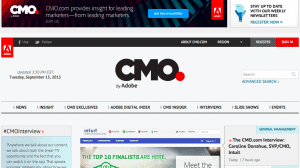
How Branded Should Your Content Hub Actually Be?
Every brand doing content marketing should create a space or central hub for the content to live. Doing so allows teams to get the most out of their marketing by consolidating fragmented digital content to a one-stop-shop. While creating a central hub is a universal best practice, the amount of branding that a hub should have is a different story. This is a challenge many marketers face and is one they all have approached very differently. Although there is no right or wrong answer, there are a few factors to consider that will help steer you in the direction that’s right for your brand.
Branded
Having a content hub that’s “branded” means the look and feel is aligned with the overall company branding. The colors, typeface, imagery and experience should be similar to that of the brand’s site and other marketing materials. This also means that the hub has a domain that includes the brand (ie: https://www.brand.com/blog or blog.brand.com).
A content marketing team may choose to have a branded content hub for a few reasons. First, having a branded URL for a content hub provides strong domain authority and will deliver high volumes of search traffic almost immediately. Second, it’s a good choice for a brand that already has a positive perception. For a brand that has a poor perception, a branded hub may not be a great choice, since its audience could dismisses the content immediately, assuming it’s promotional.
Let’s look at a branded example: Pepsi Pulse by Pepsi
Pepsi’s content hub, Pepsi Pulse, leverages Pepsi’s domain authority and actually lives right at pepsi.com. As you can see, the site looks and feels like Pepsi, with its logo and product clearly displayed. Pepsi’s social accounts are also pulled onto the site, making the destination truly a central hub for its content. The content published to Pepsi Pulse is all about pop culture and music, topics with which Pepsi wants to associate itself. For Pepsi, having a branded hub is a great choice because the brand already has a positive perception that it’s trying to strengthen even more.
Some other great examples of branded content hubs include: OPEN Forum by American Express and The Journal by MR PORTER
Unbranded
Unlike a branded content marketing hub, an unbranded hub should not look and feel like the brand. It should not promote the logo or even necessarily promote the products or services. The brand should not be included in the domain name either. While an unbranded content marketing hub can feel like a ludicrous option and be difficult to sell into conservative-thinking organizations, there are several good reasons why a brand could and should go this route.
An unbranded hub is a great choice for brands that are trying to repair trust issues with audiences from a history of too much promotional content or to disassociate from poor current brand perception. This is also great for parent companies with many sub-brands as an option to simplify and consolidate its content marketing efforts. The other reason a brand may choose this option is if they’re truly committed to producing a high-quality editorial hub and don’t want to risk any company brand association to discredit the content.
The main drawback of creating an unbranded and off-domain content hub is forfeiting existing strong domain authority search traffic.
Let’s look at an unbranded example: Makeup.com by L’Oreal
Without some digging, one would never know makeup.com is owned and powered by L’Oreal. The only indication of this is found at the very bottom of the site with a L’Oreal copyright. Makeup.com reads like a true beauty magazine with articles about trends, tips and tutorials. Not every article features makeup products however, with some revolving around food, fitness and fashion instead. While articles that do include makeup have “Shop the Story” calls-to-action, they link out to L’Oreal products on various reseller sites, eliminating the feel of a pushy sale. Social accounts featured on the site are also branded as makeup.com, rather than L’Oreal.
Choosing an unbranded hub was a good choice for L’Oreal for two main reasons. First, the parent company owns 32 brands. Consolidating these brands under one umbrella simplified its content marketing efforts and allowed them to put one strong foot forward, rather than 32 fragmented programs. Doing this benefited them in their e-commerce strategy as well. Even with articles linking out to purchase their products, there’s enough variety in the brands and price points for the “Shop the Story” to feel helpful rather than salesy. Second, the makeup.com URL was a brilliant choice, as it didn’t force L’Oreal to give up much domain authority but still allowed them to create a neutral destination.
Some other great examples of unbranded content hubs include: Forkful.com by ConAgra and Van Winkles by Casper
Somewhere in the Middle
Finally for those who can’t choose sides, there’s always somewhere in the middle. Many brands practice the art of compromise and choose a solution that takes aspects from both approaches.
Let’s look at an example that falls somewhere in the middle: Content Loop by Capgemini
While content-loop.com is an off-domain URL, the site itself looks and feels like Capgemini. A banner stating “Powered by Capgemini” at the top of the page enforces this, as does the favicon of Capgemini’s logo. While the content published on Content Loop does not mention or promote the brand’s services, the only calls-to-action and advertisements found on the site are for Capgemini.
Another great example of a content hub that falls somewhere in the middle is Bring Your Challenges by Prudential
As you can see, there are a lot of ways to approach branding of a content marketing hub. When choosing the level that’s right for your brand, be sure to keep in mind your program’s goals and challenges to ensure you’re addressing those appropriately.
This post originally appeared on LizBedor.com.
Are you interested in engaging and converting new customer for your business? Contact me here and let’s talk about how we can help.



![AI vs. Human Content: What Actually Gets You Results? [Research Report]](https://marketinginsidergroup.com/wp-content/uploads/2023/11/AI-vs.-Human-Content0.png)



Appreciate this post on a topic I’ve been thinking a lot about lately. With my company’s content efforts, most of the traffic to the content that makes up our Hub is accessed via 3rd party channels via CTA’s in social media, sites like Medium or other publications. We also generate a lot of traffic via email pushes to our subscriber base or via prominent CTA’s on our blog.
A VERY SMALL PERCENTAGE of engagement with our content comes from prospects who visit our Website and navigate to our content Hub.
Maybe things are different with us, or across our B2B world, however my observation is that readers don’t come to our website to seek out content, we either push it to them (via the channels described above), or they find it via search.
So my question is:
Why is “creating a central hub a universal best practice”?
Is it because of SEO benefits, something else or are other B2B brands having success with driving engagement across these Hubs and we just aren’t doing things right?
Hi Steve,
One of the main benefits of creating a centralized content hub that we’ve talked about many times here on this blog is that it enables you to reach, engage and convert early-stage, unbranded traffic to your digital property. That digital property then becomes an asset with a value.
We often say that the main difference between content and content marketing is the DESTINATION. You don’t own Medium or Twitter or Facebook. And while using those platforms to syndicate your brand-owned content is an important part of content distribution, the thing you want is traffic, engagement and conversion on your own media property.
So the percentage of people who navigate to your content is unsurprising and very common. The traffic your company website gets is from people who typed your website in directly. Or came in through a branded search. This is because they already know who you are, and what you sell.
But the large majority of searches on the web are unbranded. The only way to capture their attention and bring them “home” is through a branded content hub. Without it, it is just content. And it is fully dependent on the publisher site where you place it. And they are likely monetizing that traffic.
But with your own brand content hub, YOU can monetize the traffic. Oh and yes, there’s SEO benefits, but again, more for the authority on the unbranded search which makes up a bulk of all searches.
Hope that helps!
Thanks Michael, I appreciate the additional info, however am not yet convinced of the need of a Hub as a necessary place to drive inbound traffic.
Here is why….I can’t think of any instance where any marketer would drive organic traffic to a general Hub vs. a content specific landing page or directly into the specific piece of content. When readers conduct unbranded searches, they are not looking to be driven to a different page with lots of content where they need to then run yet another search to narrow down the content to find what they are looking for. They want to be driven right to that desired piece of content.
I see a similar case when serving up CTA’s within your content, whereby marketers should deliver a specific and relevant CTA (i.e. “Read this report on Measuring ROI”) vs. a general CTA (i.e. “Click Here to discover more content in our Hub”).
So then if the above is true, a Hub becomes a tool for discovery, which as I’ve observed is something it is very rarely ever used for???
Maybe my notion of a hub is too narrow, or assumptions on best practices for driving Inbound traffic incorrect???
However the more I think about it, and as counter-intuitive as it sounds, I am actually starting to believe that the main necessity of a Hub is merely a strategy to give website visitors the at-a-glance impression that your brand is a “Thought Leader” in the space vs. as a center for discovering and actually engaging in content.
This is still just the start of an assumption however, so welcome any thoughts / data points from others to the contrary…
Hey Steve,
I appreciate the dialogue as I’m sure you are not alone. Let me start by saying that within the content marketing practitioner space, having a dedicated content hub is seen as a mandatory step to a content marketing strategy that delivers a return relatively higher than other investments. This is based on research and objective reviews of those who see the highest ROI. But you should do your own research. I believe that as soon as you start to look across successful vs. ineffective content marketing programs, the successful ones focused on building a dedicated content hub. They created a media asset that grows in value over time.
You have to look beyond the article and look at the hub as an asset. A landing page has a spike in traffic that slowly reverts to zero. Landing pages serve a single need. Whereas hubs serve multiple needs of the larger majority and grow traffic over time without a similar investment in time and money. Evaluating landing page effectiveness is actually how I funded content marketing at SAP. High investment, high bounce rate, low organic traffic, low social shares. Landing pages cost money to build. A hub is a single investment in the platform and then the focus is on continuous content published.
That growing traffic can be monetized like a publisher monetizes their traffic. Except for brands, that monetization is in the form of e-commerce, leads, subscribers that can be nurtured.
Most people come for one article, but will leave if they don’t see the site as an authority. We make those judgements based on the volume of content, the breadth of authors, the consistency of publishing. That’s why landing pages have bounce rates of 90%+. Blogs are more like 50-80%. Corp websites are closer to 40-60% because people sought out the brand.
The promise of content marketing is to attract an audience vs. buying one. Ads and landing pages and cold calls require investment for each conversion. Content hubs achieve conversions even if you stop investing in the platform. It’s an asset with growing value and accelerating return. AMEX Open Forum is the largest source of new cardmembers for AMEX because they built a platform that consistently delivers value to an audience that grow in size and in trust over time.
So I started by saying that this best practice is widely accepted based on a review of the different strategies a brand can employ. But I will end in saying that you should test it yourself. Brands that commit to consistently publishing quality content on a brand owned destination see higher returns than landing pages and native ads and syndication programs alone.
But the point of this article is not whether this is a widely accepted best practice or not, but on the question of how branded your content hub can be. Now THAT is a tricker question.
OK, I’m convinced. A Hub is an evolving asset vs. a place to store your thoughts….
Excellent points all around and now better understand the importance of maintaining a content hub for my brand.
I believe my original perspective was driven by experiences where the content Hub was more of a must have collection of resources vs. a living, breathing resource that visitors will actually want to favorite and return to over time.
I’d think I’m not alone in those initial thoughts however, as guessing most brands with Hubs still hold my original mindset and don’t put the necessary investment into their Hubs to drive repeat engagement. So the challenge then becomes how do you become one of the leading resources that readers will actually return to out of interest and on their own terms…???
Think you’ve facilitated enough mental shifts for this morning however, so maybe a topic we can cover another day.
Thanks again for the education! Much appreciated.
Hey Steve,
Firstly, kudos to you for taking Michael’s comments to heart and actually changing your mindset – this step alone is often the single biggest hurdle people can’t seem to get over.
As for “how do you become one of the leading resources” question, you have to be sure you’re answering the right questions; this is where research and strategy come into it.
Unless you have the luxury of having been an early adopter, like Marcus Sheridan or someone, there are only really 3 ways of getting to that level: ungodly consistency, niche targeting, or tactical one-upmanship… and while each could work on its own, you really want to do all three at once.
This means you need to keep the stamina up (others will discontinue their efforts) and be the stalwart. while making sure you’re talking about highly specific topics and showing true expertise, whether it’s evergreen content or time sensitive. Not everyone’s going to be looking for uber-specific content, but it’s not the base layman you’re always going to be targeting. Lastly, you want to look at what other content is out there, and then try to improve on it (this is a lot easier than coming up with 100% original ideas).
It isn’t rocket science, but it requires dedication and patience. Lots and lots of patience. And paid promotion of said content – trying to get your content to rank organically is one thing, but giving it a little push with Taboola or something will really help.